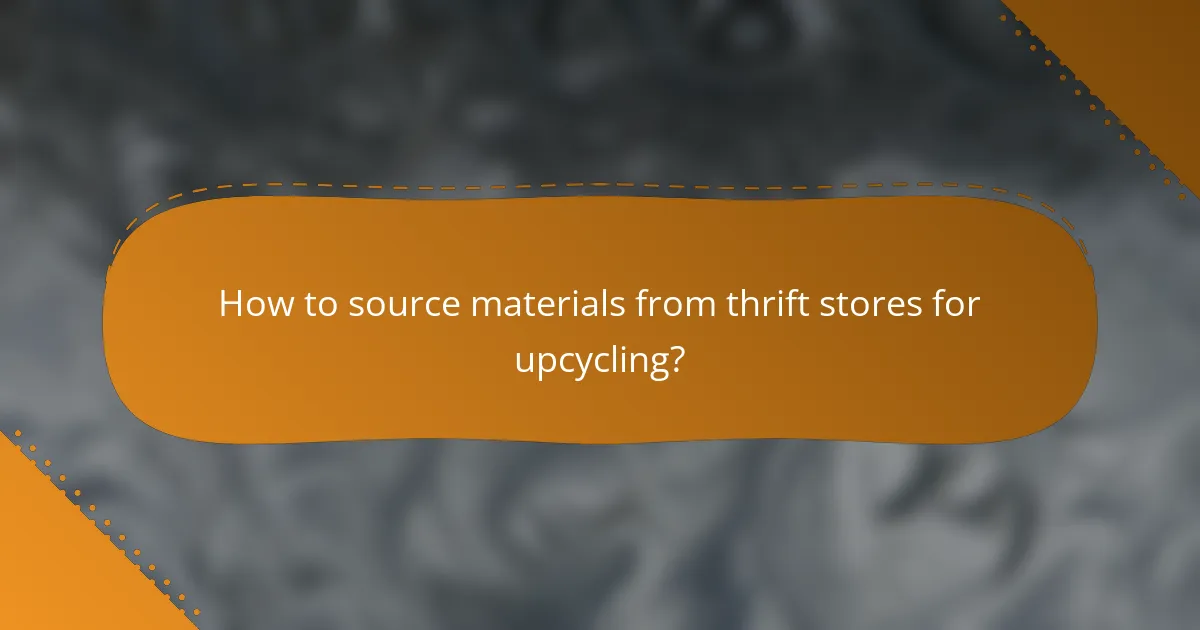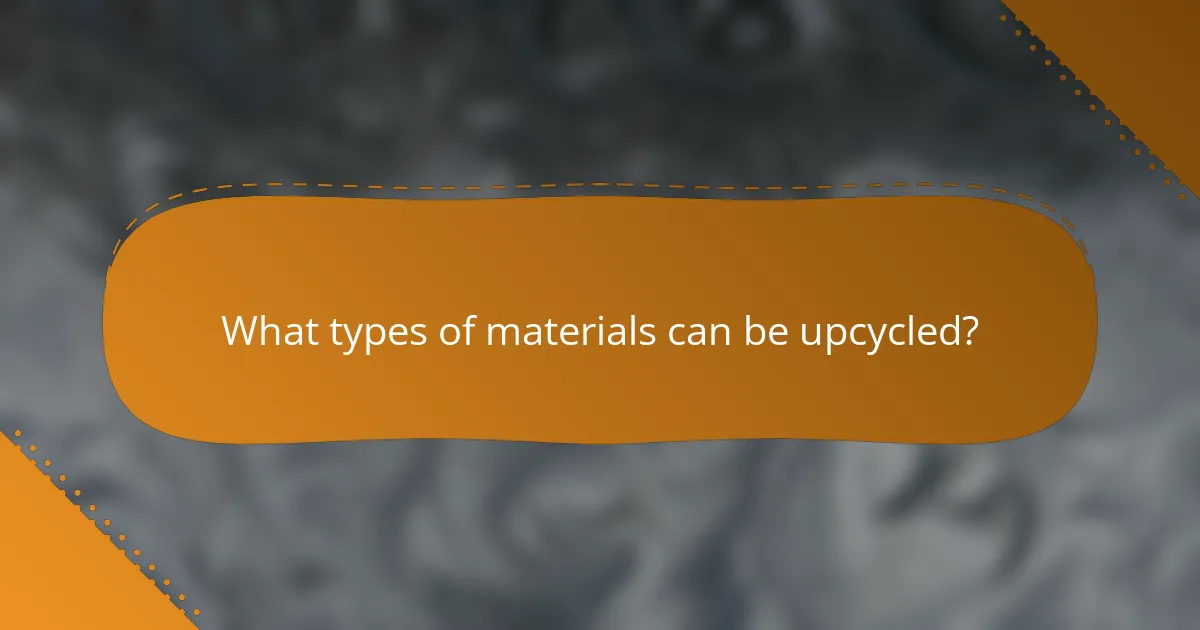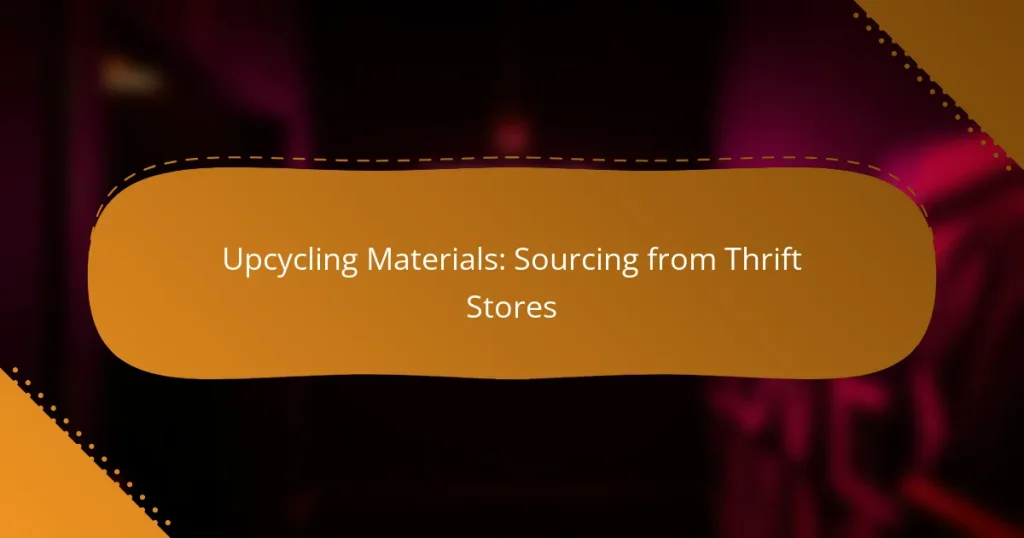Sourcing materials from thrift stores for upcycling is an exciting way to find unique items that can be creatively transformed. With a diverse range of affordable goods available, thrift stores provide endless inspiration for upcyclers looking to repurpose furniture, textiles, glassware, and wood into new, sustainable creations.

How to source materials from thrift stores for upcycling?
Sourcing materials from thrift stores for upcycling involves exploring various local and online options to find unique items that can be creatively transformed. Thrift stores often offer a diverse range of affordable goods, making them ideal for upcyclers seeking inspiration and materials.
Visit local thrift stores
Local thrift stores are treasure troves for upcyclers, offering a variety of items such as furniture, clothing, and home decor. Regular visits can yield different finds, as inventory changes frequently. Look for items that can be easily modified or repurposed, like wooden furniture that needs a fresh coat of paint or vintage clothing that can be altered.
When shopping, consider the condition of the items and whether they align with your upcycling vision. Check for structural integrity in furniture or fabric quality in textiles. Make a habit of visiting on discount days to maximize savings.
Explore online thrift platforms
Online thrift platforms have gained popularity, providing access to a broader range of items from various locations. Websites and apps like ThredUp, Poshmark, and Facebook Marketplace allow you to browse and purchase second-hand goods conveniently. Use search filters to find specific materials or styles that suit your upcycling projects.
Be mindful of shipping costs and return policies when purchasing online. It’s often beneficial to read reviews and check seller ratings to ensure the quality of the items you are considering. You might also find local pick-up options to save on shipping.
Attend community garage sales
Community garage sales are excellent opportunities to find unique and inexpensive materials for upcycling. These sales often feature a wide variety of items, from household goods to clothing, all at negotiable prices. Arriving early can help you snag the best deals before others arrive.
Bring cash and be prepared to haggle; many sellers are open to negotiation. Look for items that can be easily transformed, such as old picture frames or furniture pieces. Don’t hesitate to ask sellers about their items’ history, as this can provide inspiration for your projects.
Check estate sales for unique items
Estate sales can be goldmines for upcyclers, often featuring high-quality and unique items that may not be found in regular thrift stores. These sales typically occur when someone is downsizing or liquidating an estate, offering a chance to acquire vintage or antique pieces.
Research local estate sales through websites or community boards, and arrive early for the best selection. Be prepared to pay more than typical thrift store prices, but remember that the uniqueness and quality of the items can justify the cost. Look for items that resonate with your style and can be creatively transformed.

What types of materials can be upcycled?
Upcycling involves repurposing materials to create new items, reducing waste and promoting sustainability. Common materials sourced from thrift stores include furniture, textiles, glassware, and wood, each offering unique opportunities for creative projects.
Furniture for restoration
Thrift stores often have a variety of furniture pieces that can be restored or repurposed. Look for solid wood items, which can be sanded, painted, or reupholstered to give them a fresh look. Consider pieces like chairs, tables, and cabinets that may need minor repairs or a new finish.
When selecting furniture, check for structural integrity and any signs of damage. A small investment in materials for restoration can yield a significant return in terms of aesthetic and functional value.
Textiles for crafting
Textiles from thrift stores can be transformed into various crafts, such as quilts, bags, or home decor items. Look for fabrics in good condition, including clothing, linens, and curtains that can be cut and sewn into new creations.
Consider the weight and texture of the fabric when planning your project. Lightweight cottons are great for bags, while heavier fabrics can be used for upholstery or quilts. Always wash and inspect textiles for any stains or damage before starting your project.
Glassware for home decor
Glassware found in thrift stores can be upcycled into beautiful home decor pieces. Items like jars, vases, and bottles can be used as-is or modified with paint, etching, or other decorative techniques. These pieces can serve functional purposes or simply enhance your decor.
When choosing glassware, look for unique shapes or colors that stand out. Ensure there are no cracks or chips, as these can affect both safety and aesthetics. A simple cleaning and a creative touch can turn ordinary glassware into stunning focal points.
Wood for DIY projects
Wood sourced from thrift stores can be a treasure trove for DIY enthusiasts. Look for old pallets, furniture, or even scrap wood that can be repurposed into new items like shelves, planters, or decorative signs. The versatility of wood allows for a wide range of projects.
Before starting a wood project, inspect the pieces for rot or insect damage. A good quality wood finish can enhance the final product, so consider investing in stains or sealants to protect your work. Upcycled wood projects not only save money but also add a rustic charm to your home.

What are the benefits of upcycling materials?
Upcycling materials offers numerous advantages, including cost savings, environmental benefits, and the opportunity to create unique items. By repurposing materials from thrift stores, individuals can save money while contributing to sustainability and expressing their creativity.
Cost savings on new materials
One of the primary benefits of upcycling is the significant cost savings on new materials. Thrift stores often sell items at a fraction of their original price, allowing you to acquire materials for your projects without breaking the bank.
For example, furniture pieces, fabric, and home decor can often be found for under $20. By choosing to upcycle instead of purchasing new, you can keep your project costs low while still achieving impressive results.
Environmental impact reduction
Upcycling materials helps reduce environmental impact by minimizing waste and conserving resources. By giving new life to discarded items, you contribute to lowering the demand for new products, which often require significant energy and raw materials to produce.
Additionally, upcycling reduces landfill waste. In the United States alone, millions of tons of textiles and furniture end up in landfills each year. By choosing to upcycle, you play a part in decreasing this number and promoting a more sustainable lifestyle.
Unique, personalized creations
Upcycling allows for the creation of unique and personalized items that reflect your individual style. Unlike mass-produced products, upcycled items often have character and history, making them one-of-a-kind.
For instance, an old wooden chair can be transformed with a fresh coat of paint and new upholstery, resulting in a piece that stands out in your home. This personalization not only enhances your space but also provides a sense of accomplishment and creativity.

What tools are needed for upcycling projects?
Upcycling projects require a variety of tools to transform old materials into new creations. Essential tools can range from basic hand tools to specific supplies for painting and adhering materials together.
Basic hand tools
Basic hand tools are fundamental for any upcycling project. Essential items include a hammer, screwdriver set, pliers, and a utility knife. These tools allow you to disassemble, modify, and assemble materials effectively.
Consider investing in a good quality measuring tape and a level to ensure precision in your projects. Having a sturdy work surface and a set of clamps can also help stabilize your work as you cut and assemble pieces.
Painting supplies
Painting supplies are crucial for giving your upcycled items a fresh look. Basic supplies include brushes, rollers, and spray paint, depending on the finish you desire. Choose non-toxic paints for indoor projects to maintain a safe environment.
Additionally, consider using primer to improve paint adhesion, especially on slick surfaces. A drop cloth or newspaper can protect your workspace from spills and drips.
Adhesives and fasteners
Adhesives and fasteners are essential for securely joining materials in upcycling. Common options include wood glue, epoxy, and hot glue, each suitable for different materials and project types. For heavier items, screws or nails may be necessary for added strength.
When selecting adhesives, check the drying time and suitability for your specific materials. Always follow the manufacturer’s instructions for the best results and to avoid common pitfalls, such as using too much adhesive or not allowing adequate drying time.

How to evaluate thrift store items for upcycling?
Evaluating thrift store items for upcycling involves assessing their condition, potential for transformation, and overall suitability for your project. Focus on structural integrity, material quality, and design possibilities to ensure a successful upcycling endeavor.
Check for structural integrity
Structural integrity is crucial when selecting thrift store items for upcycling. Inspect furniture for stability, ensuring that legs are sturdy and joints are secure. For textiles, look for tears, fraying, or excessive wear that may compromise their usability.
When assessing items like wood furniture, gently shake or press to identify any wobbling or loose parts. For metal items, check for rust or corrosion that could affect durability. A quick visual inspection can save time and resources in your upcycling projects.
Consider creating a checklist for evaluating structural integrity, including points like: stability, visible damage, and material quality. This will help streamline your decision-making process when browsing thrift stores.


